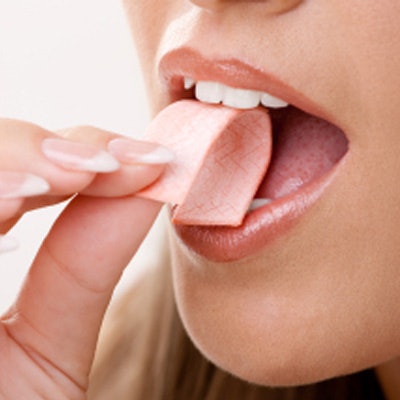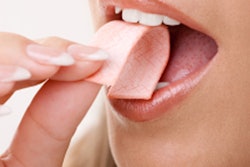
Researchers have created a chewing gum that tastes bitter when patients have inflammation around one or more dental implants. The gum may one day be used as an early detection method for peri-implantitis to help prevent bone loss associated with severe forms of the disease.
The gum was designed by a team of researchers from Germany, Switzerland, Italy, and the Czech Republic. In healthy patients, the gum's flavor doesn't change, but the taste becomes bitter when patients have peri-implantitis. The researchers detailed how the gum was created in Nature Communications (August 15, 2017).
"The chewing gum is an easy and early detection system available for anyone, anywhere, anytime," co-lead author Tessa Lühmann, PhD, told DrBicuspid.com. "In the future, patients will benefit from a quick and affordable method assessing whether they carry bacteria that destroys soft tissues and bones around their implant in the worst case."
Lühmann is a researcher at the University of Würzburg in Germany with a focus on regenerative medicine, including tissue regeneration and protein stability. Her co-lead author, Jennifer Ritzer, PhD, is also from the University of Würzburg.
Chewing gum that detects diseases
Peri-implantitis is one of the most common reasons for implant failure, and the disease can develop without pain or other symptoms that typically alert patients to see their dentist. Furthermore, dental professionals rely on laboratory and chairside tests to diagnose the condition, creating a need for quick and easy tests that can detect peri-implantitis inside or outside of a dental clinic. The team of researchers thought chewing gum may be a feasible solution.
When tissues surrounding an implant become inflamed, the body produces protein-degrading enzymes that are present in saliva. The researchers designed the gum to specifically react with these enzymes so that it breakdowns and releases a bitter taste when exposed to diseased saliva but remains intact when exposed to healthy saliva.
 Enzymes make the gum taste bitter for patients with peri-implantitis. Image courtesy of Tessa Lühmann, PhD.
Enzymes make the gum taste bitter for patients with peri-implantitis. Image courtesy of Tessa Lühmann, PhD.They tested the gum using the saliva of 14 healthy patients and 19 patients with peri-implantitis. Saliva from patients with peri-implantitis significantly deteriorated the gum after just five minutes, and the gum continued to break down for an hour.
"Anyone can use this new diagnostic tool without any technical equipment," Lühmann said. "The method is rapid, and a result is typically achieved in just five minutes. Patients can then visit their dentist, who confirms the diagnosis and treats the disease."
The gum was designed to taste bitter because bitterness is associated with poisonous substances, and, therefore, humans are very sensitive to it, Lühmann noted. However, the gum can also contain flavors, since bitterness is not recognized equally by everyone.
"The chewing gum may offer a versatile readout; however, the approach may have its limits," she said. "For example, taste perception varies by ethnicity, sex, age, and genetics, so tolerable bitterness for one person may be unacceptable for another."
To come up with an ideal formula, Lühmann and colleagues will be testing the gum through a series of clinical trials. Lühmann estimates that the trials will take at least two years, with the end goal of bringing to market a product that can detect peri-implantitis, as well as a number of other inflammatory diseases.
"In the future, patients will have access to a quick and affordable diagnostic system to test if they suffer from viral or bacterial infection," she said, specifically mentioning the bacteria that cause strep throat and staph infections. "Patients can then visit their doctors to confirm the diagnosis and to treat the disease."



















